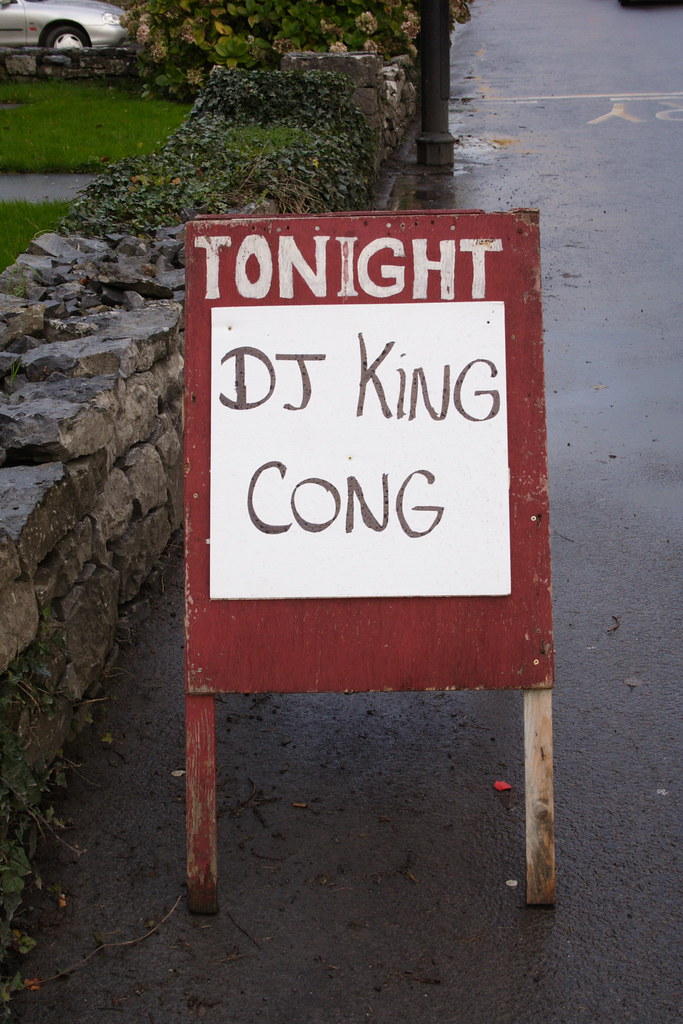November 30, 2005
She got the gold mine, I got the shaft
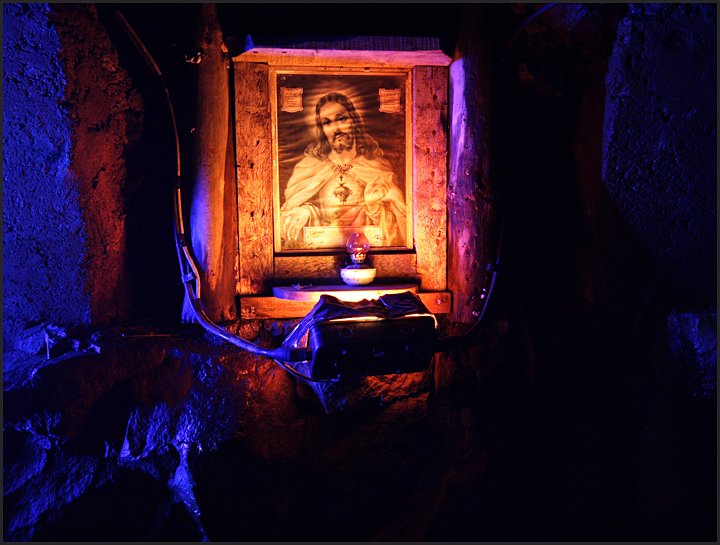
No atheists in a coal mine - picture at the mouth of the main shaft of the Arigna Coal Mine, Co. Roscommon.
We each have our own idea of what constitutes hard work - an extra hour staring at a computer, actually doing the hoovering when asked or a day at the bog. But there are some jobs that define the concept of hard work. Such is coal mining.
I have a particular interest in coal mining - my grandfather worked anthracite from the mines in Castlecomer, Co. Kilkenny. Arigna in Roscommon shared a common trait with the Castlecomer mines - narrow seams, making it even more awkward for the miners to hack out the coal from the surrounding rock. But unlike the 'Comer mines, the coal in Arigna was poor - this fact didn't make it any easier to chisel from the ground. A miner in Arigna would hack three tons of coal a day with a pickaxe using only candlelight to guide him.
Think if someone asked you to shovel 3 tons of rock into a trailer. While lying on your side. In the dark. How about if you had to hack it from a rockface first. As the disaster in China this week demonstrated, mining remains a dangerous business. In Arigna, the biggest killer wasn't the dynamite used to blast out the paths to the coal seams, or tunnel collapses. Instead, it was a fine white dust kicked up by the drills that the miners used in the latter years of the mining operation, enfeebling the strongest and most formidable of men. It was silicosis, cuased by inhaling dust from the silicate rock that surrounded the coal. The simplest of solutions - a hosepipe of water attached to the drill to keep the dust down - took years to adopt.
The mine is a tourist attraction - it's story told by men who worked there - and well worth a visit. My own gallery is here, and there's some interesting info. on a local site here.
November 29, 2005
Curry chips @ Kilmacduagh
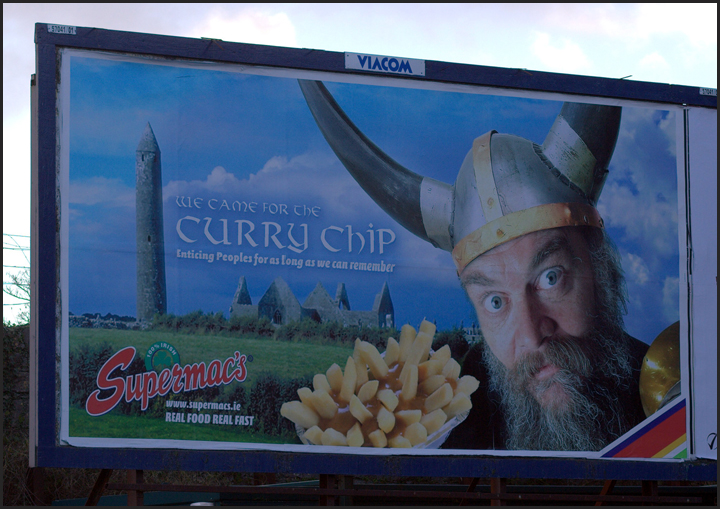
There's a groan-inducing advert running on radio for Supermacs at the moment. The conceit is that the Vikings invaded Ireland for Supermac's takeway food - the theme bears an uncanny resemblance to an ad campaign years ago for that other great amphibious assault on the digestive system - Harp lager.
As you can see from the poster, the holy settlement at Kilmacduagh is used as the background image. Kilmacduagh did suffer from Viking attacks in the ninth century - they had landed at Kinvara and marched down country. The monks were obviously expecting trouble - they had built a round tower two centuries earlier (between 610 and 620). However, round towers really weren't that safe - the Vikings simply piled up timber around them and lit them up. If the flames didn't cause the tower to crumble, the smoke drove the monks out. Luckily for the holy flock in Kilmacduagh, there aren't many trees around - it's near Gort, which would have been one big marsh a thousand years ago (it's a slightly smaller one now). There is one problem with the tower - it's leaning over, due to subsidence. How it's still standing at all is a bit of a mystery - the foundations reach only two feet beneath the surface.
The Vikings that raided Kilmacduagh were from the Limerick settlement - they pushed their luck just a bit too far when they sailed three ships into Lough Corrib in 929 (back when you could sail from the sea into the lake) and were defeated by the locals the following year.
Today, you can see a recreation of the Viking raids any Saturday night in Supermacs on Eyre Square, around 2.30 am. At least, that's what it looks like.
galway,ireland, irishblogs,monasette
November 28, 2005
Looking towards Mayo
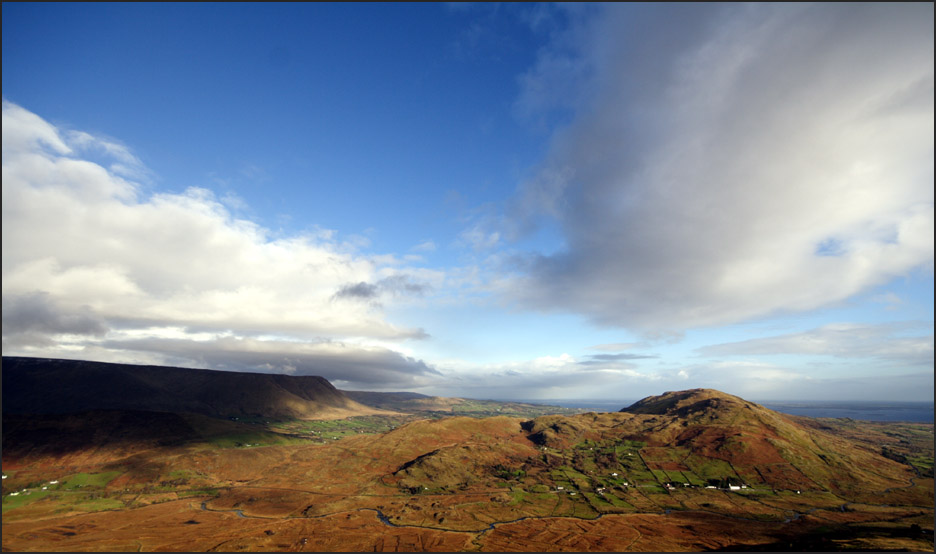
RTE's 5-7 Live news programme sent their reporter Philip Boucher Hayes out to find some snow on Friday, to see how it was affecting people. Except he couldn't find any. "Soft townie", I scoffed, as the deluge of calls and SMSes flooded into the programme with much the same message.
Except that on Saturday, when I set off to photograph some snow covered hils, I couldn't find any either. Picture above shows a mountain that doesn't have a name on any of my maps - it sits on one side of the narrow strip of Lough Mask (also visible behind the mountain) where the county boundary of Galway and Mayo meet. The thin strip of blue at its base is the Finney river, that links Lough Nafooey to Lough Mask - the Finney also marks the county boundary. On the left, under cloud, is the grim bulwark of Maumtrasna and Buckaun. A heavy hailstorm covered the top of those mountains, and about 10 minutes after I took this shot, had covered me too.
mayo,
galwayireland, irishblogs,monasette
November 27, 2005
Snowed under
If you were to get up at, oh… say 4.30 in the morning, and begin travelling west, where could you hope to be by midday ?
Sipping coffee in Manhattan ? Enjoying a G&T while flying over the Atlantic. I wasn't even drinking cold tea from a dirty shoe in a bog in Mucklagh*. Instead, I was stuck in Ahascragh (pronounced aagheraahghhaayyrrygrgh).
I had intended to take the early train east. It leaves Galway at 5.30, but, on the spur of the moment, I decided to drive instead, so that I could visit my parents after work. As soon as I left Galway, the snow began. It was heavy but the roads were clear and didn't seem icy. An hour into the journey, the car shuddered, lost power and stopped. I didn't have time to pull in so the car was slightly jutting onto the other side of the road. I was stuck.
I switched on the hazard lights, and took the breakdown kit out of the boot. The kit had a collapsible reflective triangle that you're supposed to place on the road behind the car. As I struggled to assemble it, my mocking words to a lady friend (who had admitted that she'd never looked inside the boot to see if there was a spare tyre there- "that's what the AA is for", she said) came back to haunt me. I was still struggling with the triangle when a car came along the road. The driver slowed, manoeuvred his car carefully past mine and sped off. [If only half the prayers that I said for that D-Reg Good Samaritan come through, he won't see Monday]. The next car that came along did stop, and the driver helped my push the car off the road. I assured him I'd be OK, because I had AA [Automobile Association] cover.
Ah yes, the A feckin A. I rang the help-line a little before 6.30 and gave them my location. Because I had an Ordnance Survey map in the car, I was able to locate for the operator almost exactly where I was (which was still the middle of nowhere). "No problem", said the switchboard operator, "it might be up to an hour before the tow truck gets to you but he'll call beforehand". One hour later, and no calls, I rang back. A different voice didn't seem to know about my predicament. "It could be hours before some one calls out to you". Some words were exchanged. The voice said that she would call the tow-truck driver and he would call straight back to say when he could call out. Another half-hour passed.
While I was stuck on the roadside. I occasionally tried to restart the car. No luck. While I was waiting (in vain) for the truck driver's call, I had another go. It started! And it stayed running!. I looked at the map. The nearest village was Ahascragh. I made a run for it. Once I got to the village (where, mercifully , there was a petrol station where I could get coffee), I rang the AA for a third time. A third voice didn't seem to know when, or if, I would be rescued. He gave me the number of the truck driver so I rang him myself.
You're WHERE !?!, came the response, and no, I wasn't on his list. He gave me the number of the other tow-truck handling the Galway calls, commenting that 'you could be waiting a while…'. I had to make some other calls explaining that I was stuck in Ahascragh - for some reason, everyone found this hilarious. Except me.
Then I got a call. The first truck driver had rung another driver who handles some of his overflow work - that driver was coming from the scene of a crash (not serious) and would be there shortly. When the tow-truck arrived, the driver had a look under the bonnet but couldn't see anything wrong. Just as he was about put the car up on the truck, another driver parked at the petrol station came over. AA?, he asked. He had just filled up his van with petrol, gone in to pay, and returned out to find that the van wouldn't start. No power (maybe there's an Ahascragh triangle). And just at that moment, my AA guy had pulled into the courtyard, in front of him. What luck.
I had one bit of luck myself. Because the car would start, I had no power, and therefore no heat. The temperature had below freezing, and normally, I would have frozen in the car, or had to walk to a nearby house in the snow (I was dressed for the office. But I had planned to go walking for the weekend, so I had mountain boots, fleece, jacket, gloves, cap and even salopettes (ski pants). So I could have walked back to Galway if I had to. But the only reason that I was rescued at all was due to the initiative of the drivers, who are subcontracted to the AA. But the organisation itself, for all it's fancy call centre, website etc., were no closer to helping me after a two hour wait than it was when I first called. If I had urgently needed assistance, they wouldn’t have been much help. I'll be sending them an Email , but if they're as prompt in replying as they were in helping me, I'm not expecting a prompt reply.
Later, I rang my parents to tell them of my adventure and that I wouldn't be able to visit them that evening. "Oh, we're not at home - we decided to go up to Dublin this weekend", came the reply. Just wasn't my day…
*Not all it's cracked up to be.
galway,ireland, irishblogs,monasette
November 22, 2005
Nailed
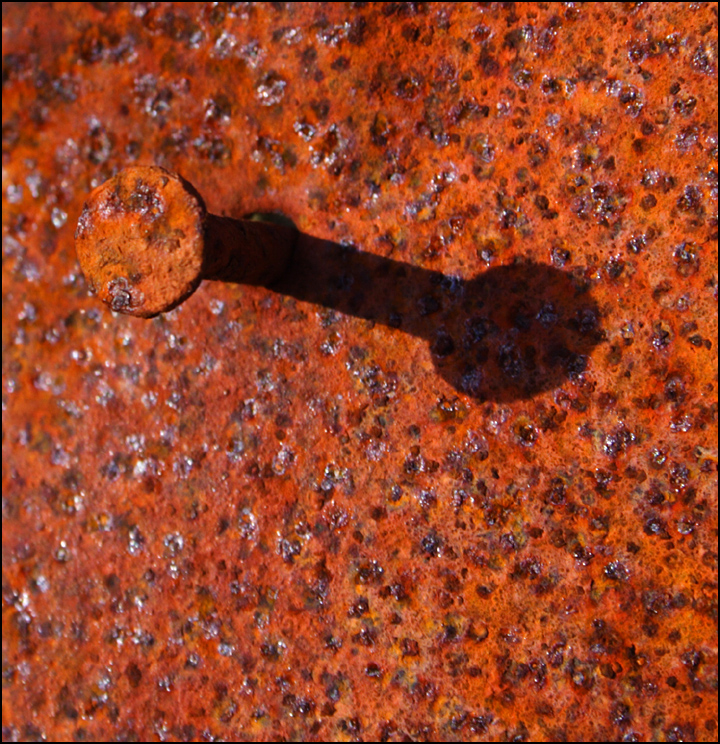
Rusted fencepost, west Galway.
galway,ireland, irishblogs,monasette
November 21, 2005
Bell Harbour
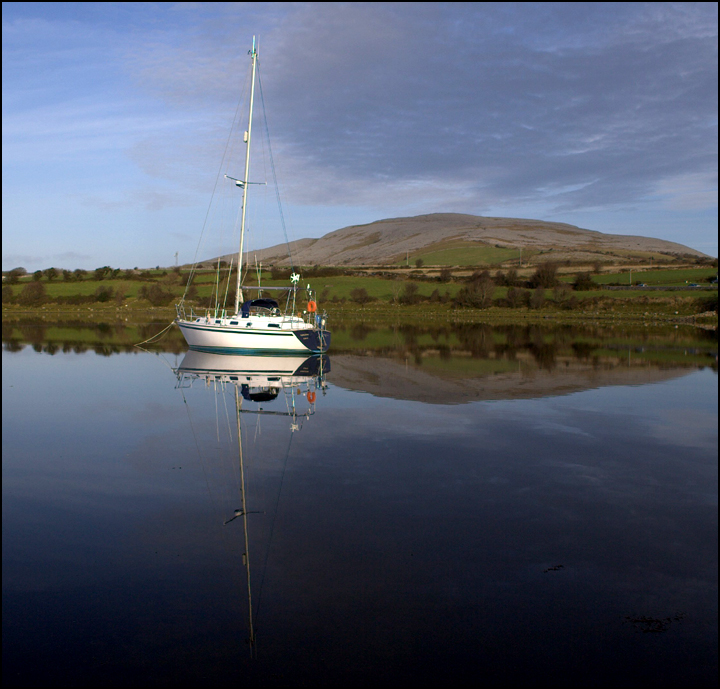
Yacht moored in Bell Harbour in the Burren - Abbey Hill is in the background.
Whole Lotta Roisín
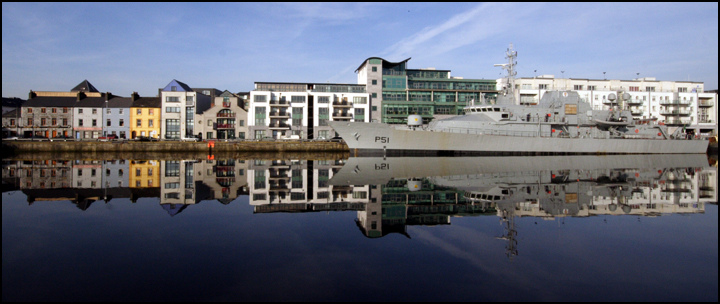
The L E Roisín in port. On the left is O'Conaire's.
The view outside my window is that of constant arrivals and departures. The docks in Galway is rarely empty and never quiet. There are the petrol tankers from Milford Haven, constantly crossing the Irish Sea in an effort to keep Galway's insatiable thirst for oil at least half-quenched. There are the sail boats (sorry, yachts), growing in number all the time. There are the 'exotics', rigged sailing ships like the Asgard, the Jeannie Johnson or private racing yachts that attract the most attention. My favourite is the Celtic Explorer, the Marine Institute's research vessel. When moored, it towers above the surrounding apartment buildings, and at night, with its many gantries, cranes and levels under floodlight, it looks like it should be in a James Cameron flick.
Looking at ships tied up in the docks is a bit like looking at actors backstage - the real action is elsewhere. No matter how wild the weather, the ships are safe in port. The Inner Dock is separated from the sea by a lock-gate, which means that water is always calm. It also means that the ships follow the calendar of the tides, rather than that of day or night, since the tide must e nearly full before the lock gates can be opened. It's not unusual for me to go to bed late at night with a dock full of ships filling the view of my living room window, only to find, like a one-night stand, some of them had slipped out during the night.
For most of the ships, a visit to Galway is a chance for rest. For the fishing boats, most of the unloading takes place at Rossaveel, where the processing factories are located. Ok, it's not the only reason. The Irish Naval Service ships also call into Galway, and sometimes they too bring in a catch. The L. E. Roisín is in port at the moment, and moored beside it is a fishing trawler that it brought in for alleged fishing violations. (Like almost every other form of food production in Europe, fishing is subject to strict quotas, which means that the trawlers spend a lot of time in port).
The boats aren't the only source of activity in the Docks. O'Conaire's (aka Padriag's) is Galway's early morning pub - ostensibly to serve the needs of the boatmen, but as often as not, the last port of call after a hard night out on the town. Contrary to popular belief, it does close at some point at night , and on more than one occasion, I've seen revellers curled up outside the door, sleeping like babies (40% proof babies, that is). Bless.
galway,ireland, irishblogs,monasette
November 20, 2005
Lunch time
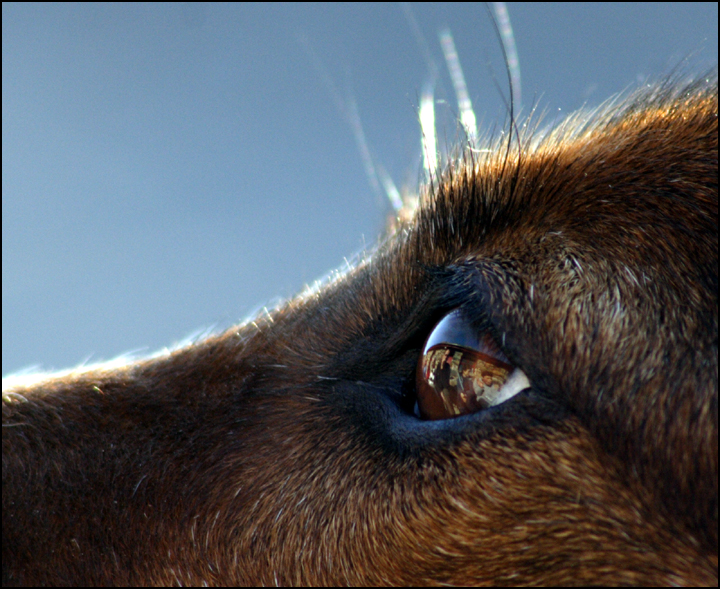
Hungry walkers reflected in the eye of an even hungrier dog, on the Killary walk today.
It was a beautiful crisp day today and perfect for walking. the Galway Walking Club had 39 members out for a walk around Killary fjord - I've never seen it look better. As usual, we stopped for lunch after a couple of hours walking. Usually, lunch means munching the sandwiches while sitting on wet bog. Today, we sat on a stone ledge, warmed by the sun, in front of a cottage. The neighbour's dog wandered out, and like an old pro, wheedled snacks out of everyone. Big brown eyes and a waggy tail will get you far in life.
galway,ireland, irishblogs,monasette
November 15, 2005
Flaggy Shore at Sunset
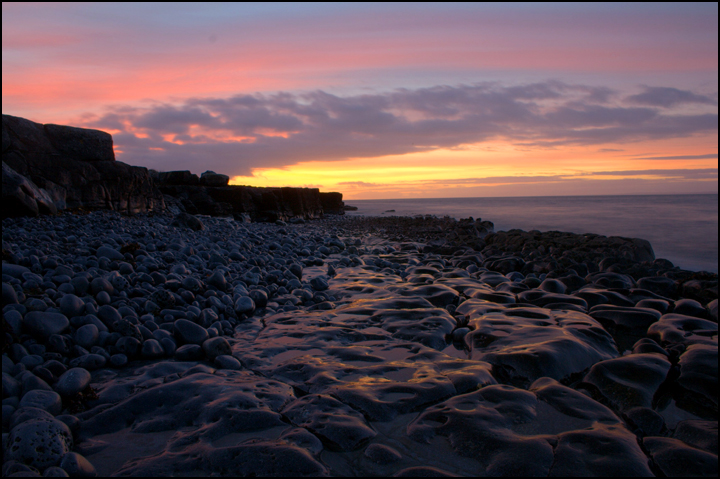
Where the Burren meets Galway Bay...the Flaggy Shore is the stretch of limestone slabs that run into the sea along a stretch from New Quay to Finavarra Point. Picture taken last Sunday evening.
clare,ireland, irishblogs,monasette
November 14, 2005
Western Corridor
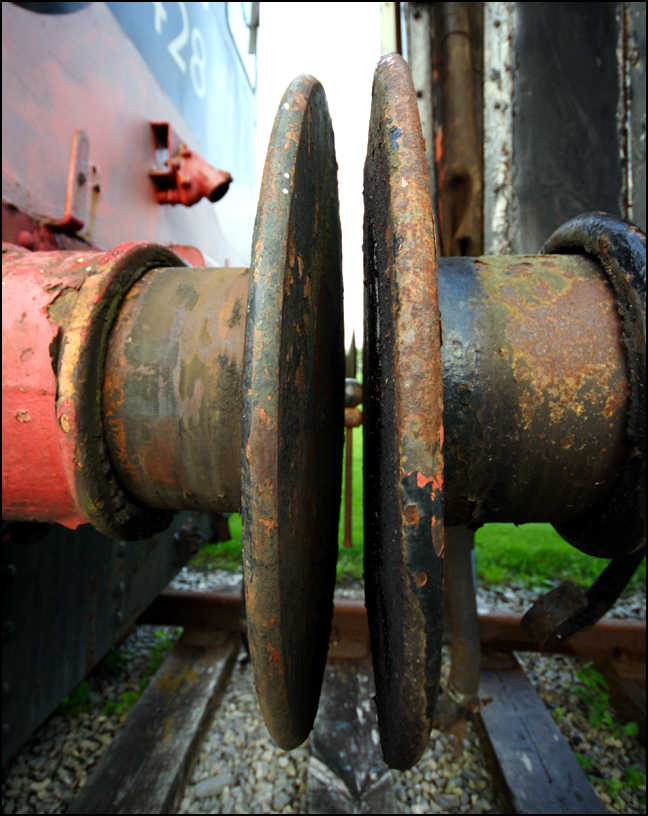
The government seemed a bit put out that the country didn't descend into euphoria at the unveiling of their Transport 21 initiative - a plan to spend massive amounts of money on the country's infrastructure. And it is a lot of money - 34 billion euro over the next 10 years, or 9.4 million per day during that period. The public's scepticism might be just down to the fact that we are a nation of begrudging feckers. OR maybe it's because some of the projects have already begun, or is it because a government announcing grandiose plans for the next ten years just 18 months before an election might deserve a pinch or two or salt. Or maybe it's just because, at this stage, Minister Martin Cullen could announce the Second Coming with Jesus sitting beside him, and people would still find it hard to believe him.
After years of campaigning, the west will get not one, but two "Western Corridors" - a rail link from Limerick to Sligo, and a road link from Donegal to Waterford. Uh, Waterford? Ah yes, the so-called Atlantic Corridor is designed to link all the major towns and cities, from Donegal through Sligo, down to Galway and on to Limerick before finishing in Cork. And then it will continue on to the Minister's own constintuency. Which is nice.
After years of campaigning, the Western Corridor rail link will be re-opened, which will link Limerick (via Ennis) to Galway (via Athenry) and on up to Sligo (via Tuam) - see the map below. What makes people suspicious is the fact that the Corridor won't be completed for a decade (it will be one of the last parts of the Transport 21 Plan to be completed), despite the fact that most of the infrastructure is already in place). The rail line already exists, as do the stations - the line and signalling need some upgrading, but there will be no need for planning enquiries or compulsory purchase orders - usually the main cause of delays to major infrastructure projects. So the suspicion remains that the plan for the Western Corridor is as much aspirational as realistic. Say it ain't so, Martin.
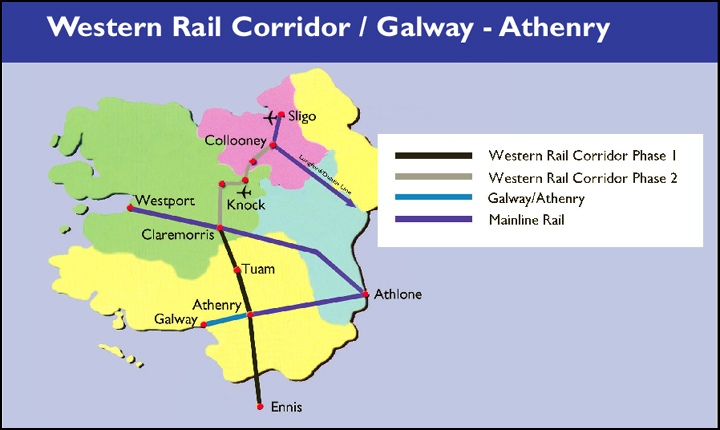
The Minister has promised that no new road projects will have toll booths, which overlooks the fact that many of the road projects in the Transport 21 plan have already started (are therefore not classed as new). Tolling is a vital part of the Public Private Partnership model that the government has pursued to pay for these projects - private companies foot the cost of building the road infrastructure, and in return, levy tolls for a number of years. A similar policy in the UK has generated a lot of heated debate (particularly after the privatisation of the rail network was seen as a failure), but curiously little discussion has taken place here. In fact, most of the discussion centres around the toll-booths on the M50. Most Dublin commuters would like them removed since they are held responsible for huge traffic jams at rush hour (you can hear Olivia O'Leary having a roight auld whinge about it here). There are two problems with this campaign; firstly, the revenue that would be lost by removing the toll booths is roughly equivalent to the price of the Western Corridor (so where would the extra 350-400 million come from), and secondly, if the M50 is seen as a failure of the PPP model, why isn't there an outcry at the proposed introduction of toll-booths on other roads, such as the future Dublin-Galway motorway. Or maybe , for the largely Dublin-based Irish media outlets, it's only a problem when it's Dubs sitting in a toll queue. Hmmm....
galway,ireland, irishblogs,monasette
November 13, 2005
Elphin Windmill
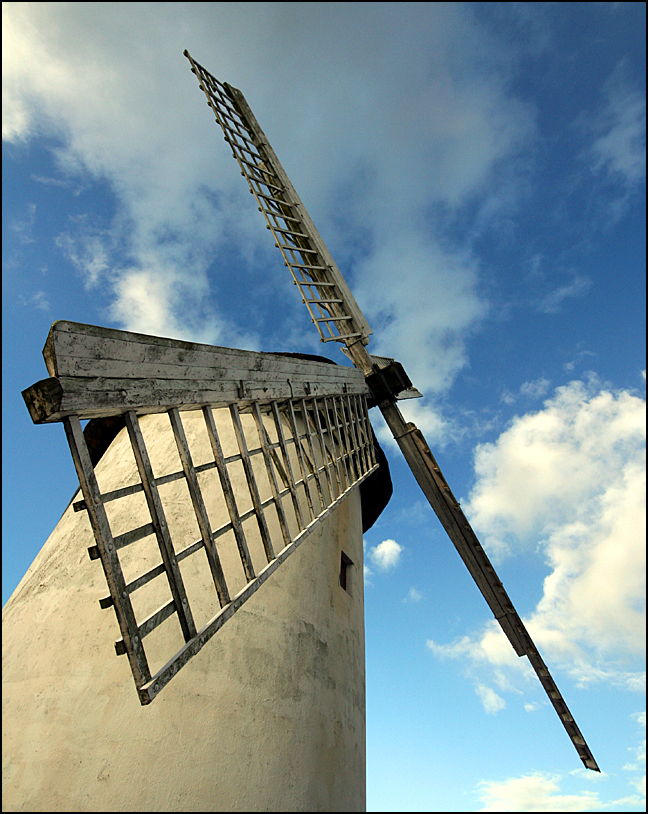
This week, Winter has been preceded by a fanfare of shrieking wind, icy rain and the gentle nip of frost (though today was a warm sunny day). The silver lining was that the rough weather generated a bit if electricity, thanks to all the wind turbines lining many of the hills around the country. Ireland doesn't have much of a tradition for wind power, but there are a few restored windmills around the country. This one, in Elphin, Co Roscommon, spent more than 100 years grinding corn before the practice ended during "Black 47", as the Famine worsened. This photo was taken just before the gales last week - it's still standing, though.
roscommon,ireland, irishblogs,monasette
November 10, 2005
Chiyo Maru
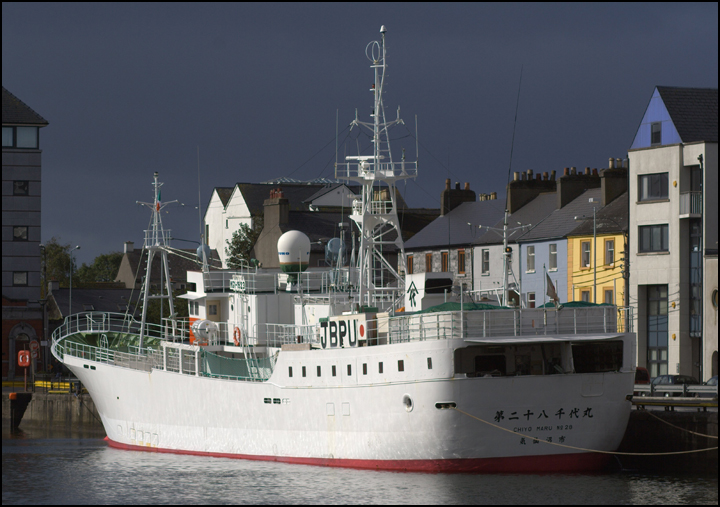
The Docks in Galway receives many visitors and few are as well travelled as the fleet of Japanese fishing boats that spent last month tied up in the harbour (and any visiting whales might want to keep their heads down while they're here). This ship, conveniently parked outside O'Conaire's early morning bar (funnily enough, the spot where the Irish Navy ships usually park), is named the Chiyo Maru No. 28. The first ship to bear that name met it's end during World War II, sunk by a US submarine called the Tambor, commanded by a John M Murphy. That action took place almost 80 years to the day after another John M Murphy, born of Ireland but commanding the Ironclad Carondelet, led his crew in support of the battle for Vicksburg (Murphy's commander, Admiral Porter, said of his fleet during the battle - when told of the loss of one of his ships - that he 'was willing to lose all the boats if he could do any good').
galway,ireland, irishblogs,monasette
November 09, 2005
The Road to Kylemore
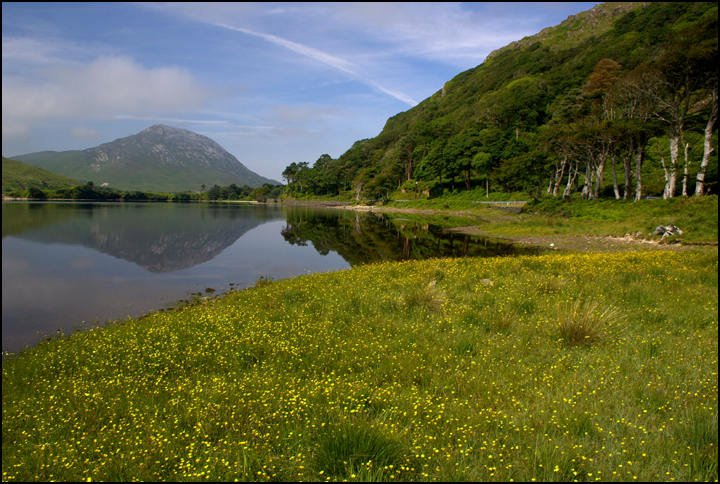
On this wild and wet November evening, here's a reminder of what the summer was like, on the road to Kylemore Abbey, with Diamond Hill in the distance (though my memory of taking the photo was the bloody midges).
galway,ireland, irishblogs,monasette
November 03, 2005
Good Versus Evil
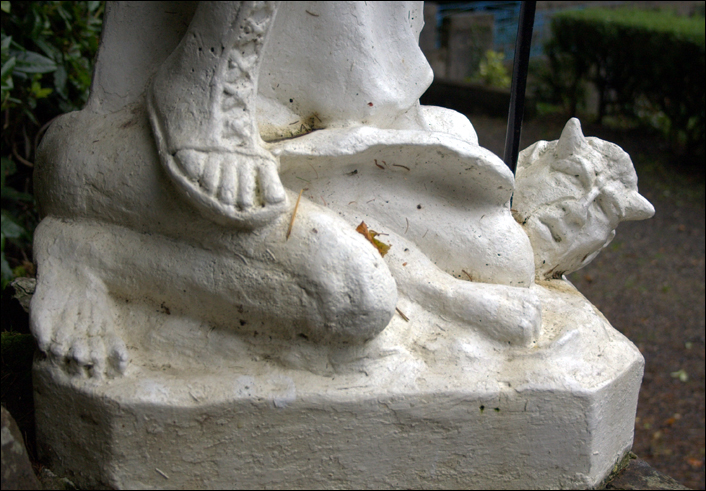
Detail from holy grotto in the Nire Valley, Co. Waterford. I'm away for a while so no updates until late next week. Don't get up to any mischief while I'm away...
waterford,ireland, irishblogs,monasette
November 01, 2005
Disabled Parking
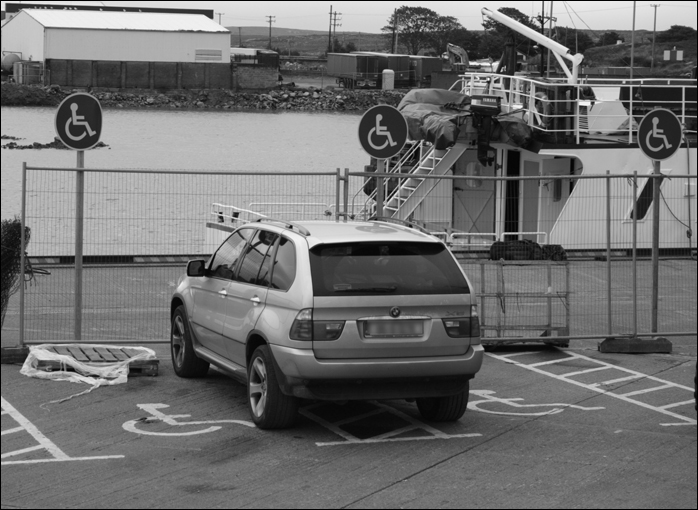
Maybe he's blind...disabled parking in Rosaveel.
galway,ireland, irishblogs,monasette
Reflections
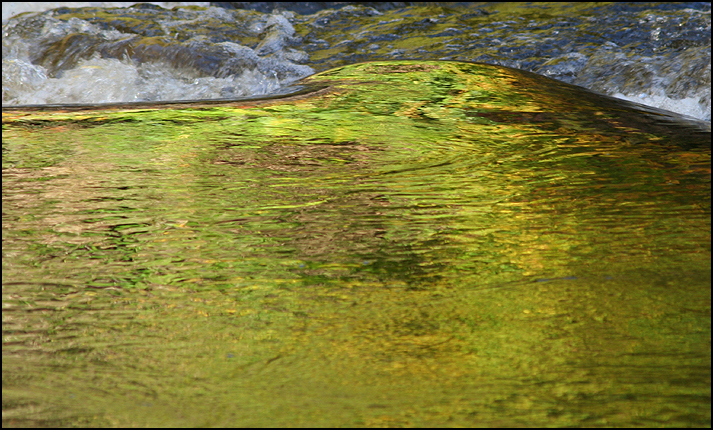
Autumn colours reflected in the Bonet River at Dromahair. I think that's enough photos from Leitrim for the moment...
leitrim,ireland, irishblogs,monasette
